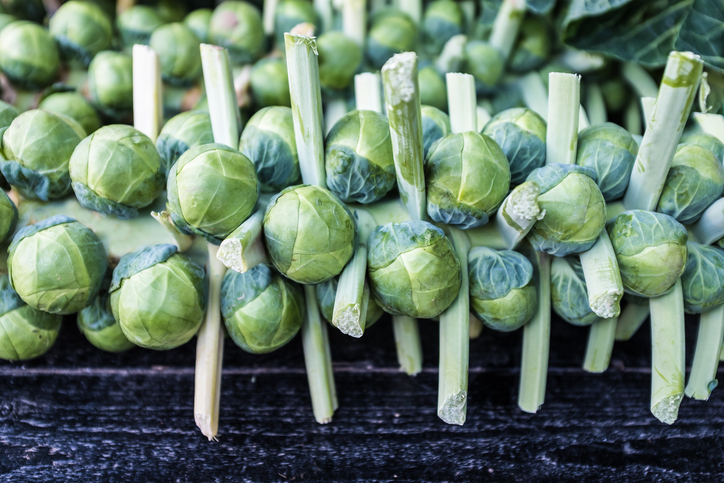
Eating healthfully would be a whole lot easier if we were all born loving Brussels sprouts.
Unfortunately, when it comes to adoring whole, healthy foods, the cards are stacked against us. You can largely blame your parents for that.
While all people are programmed to have similar taste preferences (liking sweet, salty and umami flavors and disliking sour and bitter flavors), a very small portion of what we do or don’t like to eat comes down to genetics, explains Elizabeth Phillips, a professor of psychology at Arizona State University, whose research focuses on the psychology of taste. After all, some people love fish. Others hate it. And some like Brussels sprouts, even if those tiny cabbages aren’t fried up with bacon.
What does determine what we do and don’t like to eat, however, is predominantly what our parents fed us – even before we were born. For instance, what mothers eat flavors both their amniotic fluid that a fetus inhales and exhales during pregnancy as well as their breast milk, says bio-psychologist Gary Beauchamp, emeritus director and president of the Monell Chemical Senses Center in Philadelphia.
For instance, his research, published in the journal Pediatrics, shows that infants whose mothers drank carrot juice late in their pregnancies or while breastfeeding like carrot-flavored cereal more than those who have never before tasted carrots. And as we continue to eat those foods and others throughout our first years of life, our tastes continue to develop and change, he explains. What we like doesn’t just determine what we eat. What we eat determines what we like.
However, when we hit about age 2, we start to become neophobic, refusing to try any new foods. “Past the age of 2 of 3, most mothers will find that their kids won’t eat the healthy foods they introduce for the first time,” Beauchamp says. “It’s frustrating, but it’s probably meant to be a good thing. In our evolutionary history, this is the time of life when children began to move away from their mother and feed themselves. They needed to be wary of new foods, especially bitter ones, to survive.”
After all, in the wilderness, you don’t know if a new food is safe – or poisonous – until after you eat it. And foods that smelled and/or tasted sour or bitter were more likely to be underripe, rotten, or even poisonous, he explains. Trying new foods wasn’t worth the chance.
It just so happens that broccoli, kale, tea, and even tomatoes are regularly perceived by first-time eaters to be bitter or sour, he says. So, if you weren’t eating these foods at age 2, it’s unlikely that you like them now. (That’s also why it’s so important to introduce your kids to these foods as early as possible.)
Learn to Like Healthy Foods
Fortunately, even past your terrible, “I only want to eat macaroni and cheese with cutup hot dogs” twos, you can still learn to like healthy foods. Follow these tips to start eating your veggies like candy:
1. Eat them for a few months
As an adult, learning that a food is “safe” (and therefore tasty) often requires repeated exposure – just like in your younger years. “Familiarity breeds liking,” Phillips says. “Exposure to any food over and over produces liking – in neophobic 3-year-olds, this takes about 20 times. So although exposure works, it is tough love.” When trying to learn to like healthy foods, she recommends eating it regularly for at least two to four months. After that time, you should at least tolerate the food, if not altogether love it.
RELATED: How Long Does It Take to Form a Healthy Habit?
However, it’s worth noting that this trick works best with foods that aren’t altogether bitter, like fruits or mushrooms. With bitter foods like cruciferous veggies, you’ll want to try out tips No. 2 and 3.
2. Mask the bitterness
As every person who has ever smothered broccoli with cheddar cheese knows, you can cover up a food’s bitter flavor. For instance, salt blocks receptors in your body that are responsible for detecting bitterness, Beauchamp says. And published in Chemosensory Perception, Phillips’ research shows that both sugar and calorie-free sweeteners reduce diners’ perception of bitterness in vegetables including broccoli and Brussels sprouts.
While eating your vegetables with a ton of salt or sugar shouldn’t be a long-term solution to helping you get your five-a-day, adding a pinch to start with can make them more palatable. As can caramelizing bitter vegetables to enhance their sweet-and-salty flavor, she says. “After five to seven pairings, the taste of the vegetable itself will become liked,” she says. “This is called flavor-flavor learning,” and it’s a great way to learn to like healthy foods that you currently find nasty.
A good example is coffee, which is bitter. Most of us start by sweetening it, and then learn to like the taste of the coffee itself, and end up using less or no sugar. Or alcohol. It’s also bitter. Start with Black Russian, move on to a martini.”
3. Pump up the calories
“We are built to like foods that are high in calories,” says Phillips, noting that we would die if we didn’t eat enough calories. In a 2014 study, she taught children to like Brussels sprouts by giving them the veggies with cream cheese seven times. “They liked them plain after that,” she says. “You don’t have to put cream cheese on forever.”
She says the key to making this tactic work is not overdoing it with the high-calorie pairing, Phillips says. After all, the kids would never have learned to like the Brussels sprouts if they could only taste the cream cheese. You can also try this trick with butter, olive oil, Parmesan cheese, or any other high-calorie food or condiment.
RELATED: Why Low-Fat Diets Don’t Work
Written for Health.USnews.com